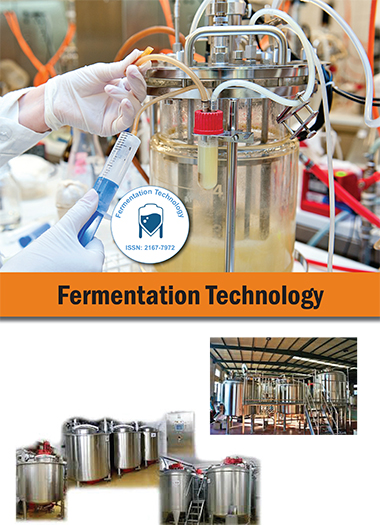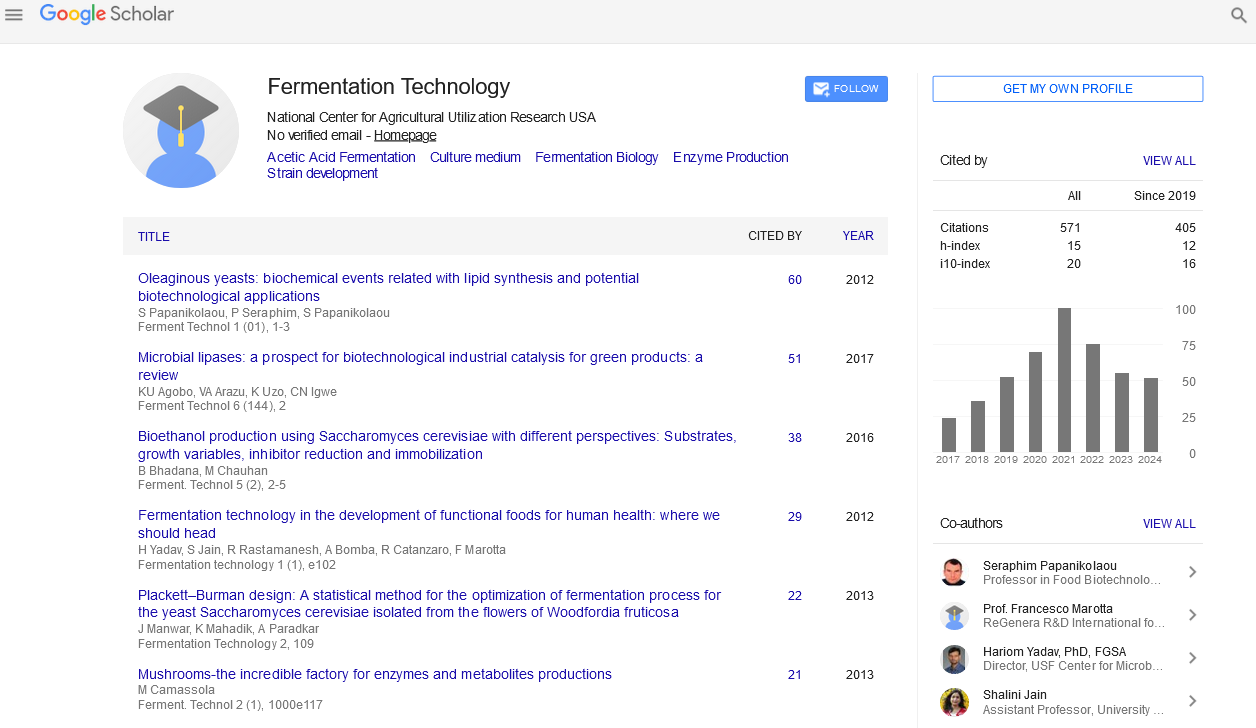Indexed In
- Open J Gate
- Genamics JournalSeek
- Access to Global Online Research in Agriculture (AGORA)
- RefSeek
- Hamdard University
- EBSCO A-Z
- OCLC- WorldCat
- Publons
Useful Links
Share This Page
Journal Flyer

Open Access Journals
- Agri and Aquaculture
- Biochemistry
- Bioinformatics & Systems Biology
- Business & Management
- Chemistry
- Clinical Sciences
- Engineering
- Food & Nutrition
- General Science
- Genetics & Molecular Biology
- Immunology & Microbiology
- Medical Sciences
- Neuroscience & Psychology
- Nursing & Health Care
- Pharmaceutical Sciences
Perspective - (2025) Volume 14, Issue 1
Integration of Fermentation and Downstream Processing for Cost-Effective Biopharmaceutical Production
Ben Wilson*Received: 26-Feb-2025, Manuscript No. FMT-25-29070; Editor assigned: 28-Feb-2025, Pre QC No. FMT-25-29070 (PQ); Reviewed: 13-Mar-2025, QC No. FMT-25-29070; Revised: 20-Mar-2025, Manuscript No. FMT-25-29070 (R); Published: 27-Mar-2025, DOI: 10.35248/2167-7972.25.14.180
Description
The biopharmaceutical industry relies heavily on microbial fermentation for the production of therapeutic proteins, enzymes, monoclonal antibodies and vaccines. While fermentation enables the synthesis of these complex biologics, the overall cost of production is largely influenced by Downstream Processing (DSP), which can account for up to 70% of total expenses. Therefore, integrating fermentation with downstream steps in a seamless, coordinated manner is essential for improving efficiency, yield and cost-effectiveness in biopharmaceutical manufacturing.
Microbial systems in biopharmaceutical production
Microorganisms such as Escherichia coli, Pichia pastoris and Bacillus subtilis are commonly used as expression platforms due to their rapid growth, well-understood genetics and ability to produce high levels of recombinant proteins. These systems can be engineered to express therapeutic compounds either intracellularly or in the extracellular medium. The choice of host and expression strategy greatly influences the downstream purification requirements.
Challenges in traditional downstream processing
Conventional DSP involves multiple steps, including cell harvest, lysis, filtration, chromatography and formulation. These processes are time-consuming, expensive and often require significant volumes of buffers and chemicals. Recovery losses and product degradation during these steps reduce the overall yield. Batch-wise operation further complicates scale-up and introduces variability. Consequently, there has been a shift towards integrated and continuous strategies to simplify processing and improve product consistency.
Process integration strategies
Integration between fermentation and DSP can be achieved through various strategies:
In-Situ Product Recovery (ISPR): This approach involves extracting the product during fermentation, minimizing degradation and feedback inhibition. Techniques such as adsorption, membrane filtration and two-phase extraction are employed directly within the bioreactor to selectively recover the product without disrupting microbial activity.
Continuous processing: Linking upstream and downstream steps in a continuous flow allows for steady-state operation, reduced hold times and improved product quality. Perfusion bioreactors and continuous chromatography systems are being implemented in modern facilities for real-time purification.
Cell-free systems: In certain applications, fermentation is coupled with cell lysis modules to recover intracellular products on-line. This eliminates intermediate storage steps and reduces contamination risks.
Membrane-based technologies
Membrane systems such as microfiltration, ultrafiltration and tangential flow filtration are increasingly used for separating cells, concentrating proteins and exchanging buffers. Their modular nature makes them well-suited for integration with fermenters. Membranes offer high selectivity, scalability and low operating costs, making them attractive tools in integrated bioprocessing systems.
Chromatographic techniques
Advancements in chromatographic resins and column design have enabled faster and more efficient separation of biopharmaceuticals. Multi-column continuous chromatography systems offer higher throughput and lower buffer consumption. These systems can be operated in parallel with fermentation, allowing direct feed of clarified broth into the purification stream.
Automation and process monitoring
Integrated bioprocessing requires precise control over variables such as pH, temperature, biomass concentration and metabolite levels. Process Analytical Technology (PAT) tools enable real-time monitoring and control, ensuring optimal conditions throughout the production cycle.
Automation platforms allow data-driven decision-making and reduce operator dependency, thus minimizing errors and variability. This level of control is essential in maintaining product quality and meeting regulatory standards.
Regulatory and quality considerations
Integrated systems must comply with Good Manufacturing Practices (GMP) and regulatory expectations for biologics. Real-time quality assurance through PAT, coupled with Quality by Design (QbD) frameworks, supports process validation and traceability.
Documentation, risk assessment and standardization of integrated processes are key to achieving regulatory approval and maintaining consistent product safety and efficacy.
Economic and environmental advantages
Integration reduces material use, space requirements and labor intensity. Continuous operations consume less water and generate fewer waste streams compared to batch systems. Energy savings also result from reduced holding and cleaning operations.
By improving process yields and reducing cycle times, integration helps lower the overall Cost of Goods Sold (COGS), making biopharmaceuticals more accessible, especially in resource-limited healthcare markets.
Case studies and industry trends
Several biopharmaceutical companies have adopted integrated biomanufacturing platforms. For instance, production of monoclonal antibodies using perfusion bioreactors linked with continuous capture chromatography has significantly reduced processing time.
Modular manufacturing units and flexible facilities are gaining popularity, allowing rapid adaptation to new products or volume changes. These trends highlight the move toward leaner, smarter and more responsive production systems.
Conclusion
Integrating fermentation with downstream processing represents a strategic approach to improving efficiency, reducing costs and meeting quality expectations in biopharmaceutical manufacturing. With advancements in bioreactor technology, purification systems and real-time monitoring, fully integrated platforms are becoming increasingly viable. Continued development and adoption of such systems will play an important role in addressing global demand for high-quality, affordable biologics.
Citation: Wilson B (2025). Integration of Fermentation and Downstream Processing for Cost-Effective Biopharmaceutical Production. Ferment Technol. 14:180.
Copyright: © 2025 Wilson B. This is an open-access article distributed under the terms of the Creative Commons Attribution License, which permits unrestricted use, distribution and reproduction in any medium, provided the original author and source are credited.

